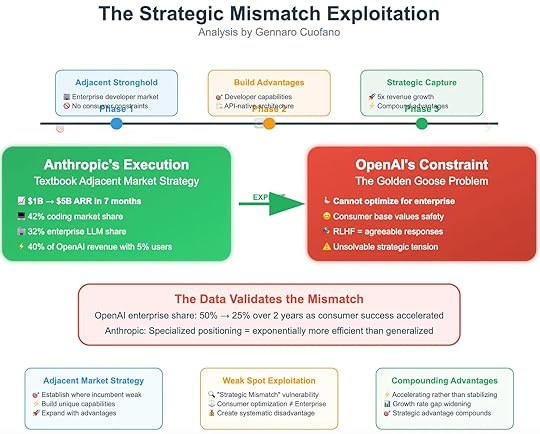The AI Strategic Mismatch Exploitation

Every market leader carries within it the seeds of its vulnerability. For OpenAI, the very success of its consumer-first strategy created an unsolvable strategic tension. By optimizing for safety and mass adoption, it constrained its ability to serve enterprise needs.
Anthropic exploited this mismatch with textbook precision. By targeting the adjacent enterprise market, it avoided OpenAI’s constraints, built unique capabilities, and captured accelerating advantages. The result: $1B to $5B ARR in just seven months.
Phase 1: The Adjacent StrongholdThe enterprise developer market was the obvious adjacent stronghold.
No consumer constraints.High willingness to pay.Demand for verifiability over friendliness.Anthropic positioned itself here deliberately. By avoiding direct competition in consumer AI, it sidestepped the RLHF constraint—the need to produce agreeable, safe outputs for hundreds of millions of users.
This gave Anthropic a structural freedom OpenAI could not match.
Phase 2: Build AdvantagesAnthropic then built advantages around this positioning:
Developer capabilities. Models optimized for raw output, determinism, and integration.API-native architecture. Monetization tied to enterprise workflows, not consumer subscriptions.This meant that every dollar of revenue Anthropic generated was more efficient. Enterprises measured value in capability and integration—not personality or safety.
By aligning with enterprise requirements, Anthropic created a one-way moat: OpenAI could not follow without undermining its consumer base.
Phase 3: Strategic CaptureWith these foundations, Anthropic executed strategic capture.
42% coding market share.32% enterprise LLM share.40% of OpenAI’s revenue with only 5% of users.5x revenue growth in seven months.This is the essence of compounding advantages. Each gain accelerated the next: higher revenue per customer enabled deeper investment in technical capability, which in turn attracted more enterprises, widening the gap further.
Rather than stabilizing, Anthropic’s growth accelerated.
OpenAI’s Constraint: The Golden Goose ProblemOpenAI faced the inverse dynamic. Its consumer success created the Golden Goose Problem.
Consumer base values safety.RLHF = agreeable responses.Enterprise optimization conflicts with consumer trust.OpenAI could not optimize for enterprise without undermining its consumer value proposition. Any attempt to loosen guardrails risked alienating its mass-market user base.
This created an unsolvable strategic tension: the very features that made OpenAI dominant in consumer AI made it weak in enterprise AI.
The Data Validates the MismatchThe numbers make the strategic mismatch explicit.
OpenAI’s enterprise share dropped from 50% to 25% in just two years as its consumer success accelerated.Anthropic’s specialized positioning proved exponentially more efficient than generalized strategies.In other words, OpenAI’s growth in consumer AI directly weakened its enterprise competitiveness. Anthropic turned this into an advantage by occupying the adjacent space.
Strategic Frameworks at WorkThe diagram highlights three frameworks Anthropic leveraged.
1. Adjacent Market StrategyEstablish where the incumbent is weak.Build unique capabilities.Expand with advantages.Anthropic picked the adjacent enterprise developer market, where OpenAI was structurally constrained.
2. Weak Spot ExploitationTarget “strategic mismatch” vulnerabilities.Recognize that consumer optimization ≠ enterprise optimization.Create systematic disadvantage for the incumbent.Anthropic built where OpenAI could not follow.
3. Compounding AdvantagesAccelerating growth rather than stabilizing.Revenue and capability advantages widen the gap.Structural disadvantage for OpenAI deepens over time.Why This WorkedAnthropic’s exploitation worked because it wasn’t a head-to-head fight. It was an asymmetric play:
OpenAI’s constraint was permanent. It could never fully optimize for enterprise without breaking its consumer trust.Anthropic’s freedom was structural. It could optimize ruthlessly for enterprise without caring about consumer perception.This asymmetry created a long-term wedge that Anthropic could drive deeper with each product cycle.
Lessons for StrategyThe Strategic Mismatch Exploitation framework offers key lessons:
Strengths can become weaknesses. OpenAI’s consumer dominance created enterprise vulnerability.Adjacent markets are fertile. True opportunities often lie in spaces incumbents cannot serve.Exploit constraints, don’t fight strengths. Anthropic succeeded not by outcompeting OpenAI in consumer AI, but by occupying the ground OpenAI could not.Compounding matters. Once established, mismatches grow, creating accelerating advantage for the attacker.Conclusion: The Exploit That StuckAnthropic’s rise is not just about good product execution. It is about strategic exploitation of mismatch.
OpenAI was locked into RLHF and consumer-first safety.Anthropic exploited the gap by building RLVR and enterprise-native capability.The result is a structural advantage that compounds over time.The lesson is clear: in strategy, the best plays exploit mismatches the leader cannot resolve.
OpenAI’s goose is golden—but in protecting it, they left the enterprise market wide open. Anthropic seized it. And now, the mismatch has become the moat.

The post The AI Strategic Mismatch Exploitation appeared first on FourWeekMBA.



